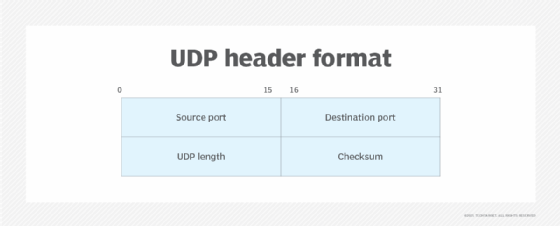UDP (User Datagram Protocol)
Where UDP enables process-to-process communication, TCP supports host-to-host communication. TCP sends individual packets and is considered a reliable transport medium; UDP sends messages, called datagrams, and is considered a best-effort mode of communications.
In addition, where TCP provides error and flow control, no such mechanisms are supported in UDP. UDP is considered a connectionless protocol because it doesn’t require a virtual circuit to be established before any data transfer occurs.
UDP provides two services not provided by the IP layer. It provides port numbers to help distinguish different user requests and, optionally, achecksum capability to verify that the data arrived intact.
TCP has emerged as the dominant protocol used for the bulk of internet connectivity due to its ability to break large data sets into individual packets, check for and resend lost packets, and reassemble packets in the correct sequence. But these additional services come at a cost in terms of additional data overhead and delays called latency.
In contrast, UDP just sends the packets, which means that it has much lower bandwidthoverhead and latency. With UDP, packets may take different paths between sender and receiver and, as a result, some packets may be lost or received out of order.
Applications of UDP
UDP is an ideal protocol for network applications in which perceived latency is critical, such as in gaming and voice and video communications, which can suffer some data loss without adversely affecting perceived quality. In some cases, forward error correction techniques are used to improve audio and video quality in spite of some loss.
UDP can also be used in applications that require lossless data transmission when the application is configured to manage the process of retransmitting lost packets and correctly arranging received packets. This approach can help to improve the data transfer rate of large files compared to TCP.
In the Open Systems Interconnection (OSI) communication model, UDP, like TCP, is in Layer 4, the transport layer. UDP works in conjunction with higher level protocols to help manage data transmission services including Trivial File Transfer Protocol (TFTP), Real Time Streaming Protocol (RTSP), Simple Network Protocol (SNP) and domain name system (DNS) lookups.
User datagram protocol features
The user datagram protocol has attributes that make it advantageous for use with applications that can tolerate lost data.
- It allows packets to be dropped and received in a different order than they were transmitted, making it suitable for real-time applications where latency might be a concern.
- It can be used for transaction-based protocols, such as DNS or Network Time Protocol.
- It can be used where a large number of clients are connected and where real-time error correction isn’t necessary, such as gaming, voice or video conferencing, and streaming media.
UDP header composition
The User Datagram Protocol header has four fields, each of which is 2 bytes. They are:
- source port number, which is the number of the sender;
- destination port number, the port the datagram is addressed to;
- length, the length in bytes of the UDP header and any encapsulated data; and
- checksum, which is used in error checking. Its use is required in IPv6 and optional in IPv4.
